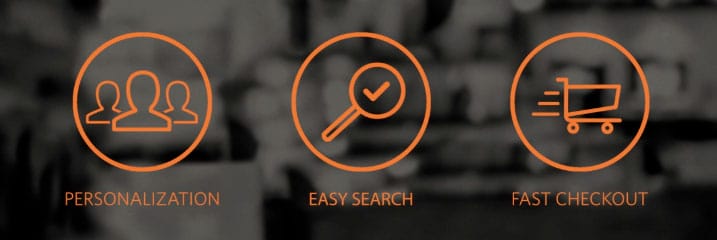Magento 2, the upgrade to the highly popular eCommerce platform Magento, was released at the end of 2015 to much excitement from the online shopping community. It has been widely anticipated since its announce way back in 2010, eBay, the then owners of Magento, promised a complete overhaul of the system, building it back up from the ground. So, with this promise of improved performance and speed, increased scalability and better use for customers, our team at Opace have explored whether eCommerce businesses should consider upgrading to Magento 2.
What Are the New Features of Magento 2?
To say that Magento 2 is an improvement from Magento V1 could be considered an understatement; the new features and performance capabilities are vast. With an improved technology stack, a smooth customization process and easier, more simplified external integrations 2.0 is more efficient, more user-friendly and more conducive to business growth and success.
We explore some of these new features below:
Speed and performance
Magento V1 doesn’t have the best reputation when it comes to page load times, and this is something that has been vastly improved by features such as full page caching. Its performance has also been improved as Magento 2 requires less hardware to scale and has CSS pre-processing. The increased performance is something that Magento users have been waiting a long time for and marks a notable difference from its predecessor.
Scalability
Scalability is another area that Magento have put a lot of focus into, and have completely overhauled the system. Some of this will be explored in more detail below, but the new updates can allow for up to 10million pages views per hour, 90,000 product orders per hour and up to 50+ product management with deferred product updates.
Mobile Responsiveness
Magento V1 was notoriously difficult to use on a mobile or tablet, but thanks to a new and improved interface you can now use either device to manage your Magento store effectively. Besides the obvious benefits for customers, it also provides a much better look and feel on mobile and tablet devices.
Replacement of the Prototype Framework with jQuery
Prototype and jQuery at one stage were fairly technologically on par, but since jQuery has progressed ahead in the market, becoming the most popular javascript library, offering a much more robust and supported system. Therefore, Magento has made the switch from Prototype used in V1 to jQuery for 2.0.
Product Videos
You can now easily add a link to a video for your product, complete with a title, description and a preview image. This marks a move away from having to previously worry about customising the whole process yourself with code, and you no longer need to worry about hosting the video or its performance.
Checkout Improvements
There have been some changes to the checkout to make it much easier to all customers, including assumed guest checkout and an automatic recognition of emails based on registered users. Features like this will make the process much smoother and quicker for the customer, and is sure to leave them wanting to shop with you again.

Split Database
In Magento V1, the same database is shared by both the admin and the customer. If you have several admins on a database at one time, the performance for the customer is going to be markedly slower. With Magento 2, you can now create three separate databases, ‘Main’, for products and configuration settings, ‘Checkout’ and ‘Orders’, both of which where the orders are stored. By splitting the databases like this, the admins can work in Magento while ensuring your customer still has the best possible experience.
Ajax Add-to-Cart
With Magento V1, every time a customer added a new product to their cart the page would have to reload; an outdated and inconvenient process, especially if they’re after a large number of products. With Ajax Add-to-Cart, the need to reload the entire content on a page is removed, and while this may seem like a minor tweak, it will improve your customer’s experience immeasurably and may even increase the number of products customers add to their cart.
Elastic Replaces SOLR
SOLR, Magento V1’s search engine of choice, was difficult to customise due to the lack of a configuration panel but has now been replaced by Elastic for Magento 2. It easily integrates with Magento, the configuration is easier and quicker with a much better solution for amending indexing settings.
RabbitMQ (Message Queue Framework)
RabbitMQ makes it easier to see where and why messages are being dropped, and it also helps to dramatically cut down your workload when integrating to a new system. It stores undelivered messages in a queue until they are picked up again by another system, much like a voicemail. It is an extremely transparent system, allowing you to easily see the list of messages and their status, which not only makes it easier for employees but can also help with customer orders.
Testing Framework
The process of testing was always complicated on Magento V1 and didn’t always adequately test that whatever you were adding new wasn’t having a negative impact on something else in your system. Regression testing, which has been introduced to Magento 2, means that this type of testing is constantly being done every time you roll out a new feature, and helps to minimise the effort required to test.
Admin Table Filtering
Admin Table Filtering allows you to change columns, shift rows and filter tables in your Magento table views. It will save you a lot of time and effort, allowing you to save your favourite ways of viewing data to allow you to access this every time that you log on, as well as enabling you to share this with other admins. In a world where being able to understand and analyse large amounts of data can lead to exponential business growth, this is a useful tool to have been introduced to Magento 2.
DevDocs
The Magento 1 documentation was lacklustre, to say the least, and Magento, building on the feedback from the community, have released DevDocs with 2.0. DevDocs is a documentation portal, driven by the community but is still moderated by Magento. All the information is centralised and much more reliable as Magento are moderating all comments.
Alongside this extensive list of features, Magento 2 will now use PHP 5.4 & 5.5, HTML 5, CSS3, and come with easier module installations, codebase scalability, product attribute swatches and support for Varnish and Redis. This has all been done to create an all round better product that improves performance, ease of use and results for both the client and the customer.
When Should I Upgrade to v2 from Magento 1?
If your system and current site are running smoothly with orders coming in, and you aren’t using an outdated version (really anything before 1.8CE or 1.13EE) with critical updates that need applying, then an update or migration probably isn’t urgent and can wait for a little while. However, Magento 2 does offer vast improvements, and it is definitely something you should start exploring, regardless of how well your current site is running, and especially if you’re considering an upgrade project anyway.
If you’re having issues with your site, such as performance issues, then a migration or upgrade to Magento 2 could be the answer. Performance issues can come about for a number of reasons, and this combined with various different third party installations, can be solved by making the jump to 2.0. Of course, you could also look at other factors, such as image compression, page caching extension, hosting, use of CDNs, and so on. Factors such as these will still need to be considered regardless of whether you’re on Magento version 1 or 2.
Magento 2 does feel familiar to its predecessor, but it may require a little training to really get the most out of it, and it’s understandable that every business may not have the time or resources for this at this current time. Magento is typically targeted at a business with a digital turnover of greater than £100,000 a year, so these business’ need to have their operations still running smoothly while a migration is underway.
How Easy Is The Upgrade Process?
The upgrade and migration process isn’t as smooth as some would wish for. There is a migration tool to help you and your data move to the newer platform, but any themes and code customizations (including third party extensions) are not necessarily transferable, meaning you would have to start from the beginning with Magento 2. In the case of third-party extensions, you will need to see whether they’re compatible, whether there is an upgrade available or roadmap for Magento 2 support and potentially consider replacing or rebuilding them.
Due to this, and on top of the cost of migrating, you would have to invest a little extra in the visual and functional upgrades. However, this will give you an opportunity to delete some of the legacy code and waste that you’ve accumulated over the years, allowing you to start afresh with a new streamlined site.
Is It Worth Upgrading?
We believe so yes, but even if you feel that the time isn’t quite right for you to make the upgrade now, the worth in upgrading will become more apparent over the coming months and years. While Magento is still supporting older versions, the majority of investments and new explorations will be done on Magento 2, so you are at risk of getting left behind if you do not upgrade now, or at least soon. If you aren’t looking to upgrade at this moment in time, it is still worth having a conversation with your solution partner about what is best for you right now or in the near future.
Things You Need to Consider
Despite the vast number of new features that Magento 2 has come set with, it is still new and as such is still in its ‘baby phase’. It has gone through exhaustive testing and robust quality assurance over the last few years, with both testing in-house and externally through its open ‘Merchant Beta’, but it is still prone to some minor bugs and issues, some of which can be found here: https://github.com/magento/magento2/issues.
However, Magento has already confirmed quarterly releases and updates for Magento 2, with the first update already being live; version 2.0.1. This latest update offers compatibility with PHP 7.0.2 for improved performances, has reduced memory consumption and also has added security enhancements. Some of these include SQL injection and prohibiting attackers from being able to access order information in the store. It should be mentioned that at this stage there have been no confirmed attacks on the Magento 2 system. The full release notes for the latest update can also be viewed here: http://docs.magento.com/m2/ce/user_guide/magento/release-notes-ce-2.0.1.html. While we have no exact details for future releases, we can expect a Visual Design Editor, new B2B Features and improvements to the quality of Magento 2’s marketplace.

Continued Support for Magento 1
Magento has also confirmed that they will slowly be phasing out Magento V1, with support ceasing three years after the release of 2.0, so this is likely to be in Q4 of 2018. Already older versions of Magento do not work on the newer versions of PHP. Many big clients use Magento such as Nike and Christian Louboutin, and some have already made the switch to 2.0 such as Alcatel OneTouch and SEAT.
If you’re new to Magento, it is a more complex system than its competition. eCommerce platforms like WooCommerce (discussed below), which can be used with simple CMS systems like WordPress ensure that it can be learned within a matter of hours, maybe even minutes. Magento, on the other hand, may require formal training. However, its complexity brings with it a vast array of more features, options and scalability than its competitors, and is a much more viable option if you are prepared to put the time in.
As Magento 2 is still in its early stages, not all third parties have adapted to the change yet, and many third party extensions are not yet available. While this will change over time, and most likely quite quickly, some companies may still decide to wait until 2.0 is more established. However, some popular extensions like MageMonkey for services like MailChimp, Facebook Connect, McAfee SECURE and Apply Coupon Code Link are still available. For a full list of third party extensions that are currently available to add to your site click here: https://www.magentocommerce.com/magento-connect/magento-2.
What Are the Alternatives to Magento?
It’s always worth weighing up the competition when considering any new piece of technology. As mentioned above, one of the biggest competitors to Magento is WooCommerce, who make it much more user-friendly to get started on eCommerce for the first time. This is because it can be installed on WordPress, which is the go-to CMS for anyone looking to set up websites easily and for very little cost. It still has hundreds of excellent features and plugins and isn’t such a drain on your resources as Magento is. Many may prefer to go down this route if time or resources are limited, but long-term Magento provides much more scalability and flexibility.
Other platforms, like ZenCart or osCommerce, have a much smaller share of the market, but still establish competition against Magento. Both, like WooCommerce, are much easier to use, with the former having a very friendly code base and the latter supporting a simple interface that makes it recommended by many hosting companies. osCommerce also has over 7,000 plugins and a brilliant community support forum in the form of over 280,000 members. While these aren’t ‘official’ osCommerce employees, their wide-ranging knowledge ensures you’ll never be stuck if you purchase the osCommerce platform.
Magento is, however, leading all three of these in terms of market share, and its scalability is unmatchable. It offers hundreds of high-quality themes and templates, and the freedom it brings means you really have the chance to build a business and an eCommerce platform that can adapt to whatever the market dictates.

We produced the infographic below last year to try and highlight some of the reasons why we believe Magento is the best eCommerce platform when to compare to alternatives such as these.

Magento 2 Demos and Examples
Magento 2 was open to ‘Merchant Beta’ in early 2015, allowing any merchants that wished to download it and trial it. They had 15 merchants worldwide who implemented 2.0, and some of these, as mentioned earlier, include Alcatel OneTouch, SEAT and Venroy, and their websites can be seen by following the links.
There is also a live demo version from Magento that is available for viewing here: http://magento2demo.firebearstudio.com.

How We Can Help
Upgrading to, or even trying to get an understanding of the new and vast Magento 2 platform can seem like a daunting and confusing process. However, at Opace, we have a team of highly professional and experienced Magento web designers, developers and marketers who can help explain the update to you, and take you through the process of installation, configuration, testing and troubleshooting. We believe that the updates Magento have implemented are only positive in nature and a switch to the newer model is more than worth it, and if you’d like help discussing this with one of our developers then feel free to get in touch with us here www.opace.co.uk or find out more information by visiting our Magento page.





